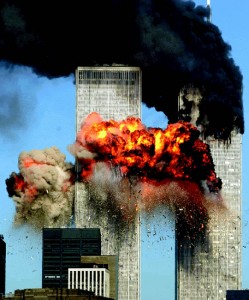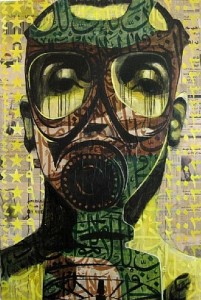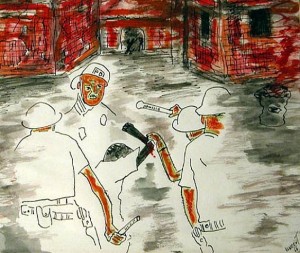 Retort. 2005. Afflicted Powers: Capital and Spectacle in an Age of War. New Edition. London: Verso.
Retort. 2005. Afflicted Powers: Capital and Spectacle in an Age of War. New Edition. London: Verso.
Despite being a relatively short book, Afflicted Powers is a difficult one to summarize. Retort* sets for itself the immodest task of identifying the international political conjuncture unleashed by the 9/11 attacks, the global anti-war protests in 2003, and the fiascos surrounding the U.S.-led invasion of Iraq. Despite intellectually fashionable insistence on the end of “Grand Narratives” and the “trap of totalization” (9), the authors do not shy away from transgressing these academic taboos. But they do so without careening headlong toward any structuralist defeatism—as unfavorable as the terrain may be. Capitalism, for instance, despite being a central category of analysis, is not portrayed as an all-seeing, omnipotent puppet master pulling the strings always-everywhere; it faces real constraints and effective opposition. The book provides a superb conjunctural analysis of impressive scope; as an endorsement on the jacket notes, “No stone is left unturned.”
The arguments of the book are explicitly directed to the “Left,” a term somewhat reluctantly defended by the authors with noted imperfections and vagueness. The book aims to communicate the gravity and stubbornness of the current political moment while discussing—albeit, too briefly—the forms and possibilities of resistance at the time it rolled off the press in 2005. (In future editions, it would be great to have a postscript with brief discussion of the Arab Spring and #Occupy, which are two major politically explosive events with great relevance to the books analysis—e.g. both events seem to have generally avoided the “vanguard ideal” that Retort finds so problematic.)
Spectacle, more so than any other concept of political explanation employed in the book, is the one that threads together the all the other key terms and arguments, while denying it holds the key to all mysteries. After the Introduction, the authors explain:
No one level of analysis – “economic” or “political”, global or local, focusing on the means of either material or symbolic production – will do justice to the current strange mixture of chaos and grand design. But one main aspect of the story – the struggle for mastery in the realm of the image – has so far been barely thought of as positively interacting with other more familiar and “material”. (19)
 Retort corrects this oversight. The realm of the image is a privileged political realm for the state, though not exclusively. And, as Retort goes on to explain, it is in this realm of the spectacle that the U.S. state suffered defeat at the hands of al-Qaida’s kamikaze pilots. Spectacle alongside its partner concept, the “colonization of everyday life,” say the authors following Debord, critiques a new stage in the accumulation of capital in which the subjection of social life to the market is maintained through the rule of appearances (the image). The conditions and possibilities of the state’s micromanagement and instrumentation of everyday life is maintained through the image world, and “control over the image is now the key to social power” (28), which is precisely why al-Qaida’s strike was so damaging.
Retort corrects this oversight. The realm of the image is a privileged political realm for the state, though not exclusively. And, as Retort goes on to explain, it is in this realm of the spectacle that the U.S. state suffered defeat at the hands of al-Qaida’s kamikaze pilots. Spectacle alongside its partner concept, the “colonization of everyday life,” say the authors following Debord, critiques a new stage in the accumulation of capital in which the subjection of social life to the market is maintained through the rule of appearances (the image). The conditions and possibilities of the state’s micromanagement and instrumentation of everyday life is maintained through the image world, and “control over the image is now the key to social power” (28), which is precisely why al-Qaida’s strike was so damaging.
Another defining feature of the new age of war is that the state is premised on weak citizenship within its own borders, while “weak” or “failed” states constitute a necessary element in the international system and world economy. But the problem for the state amid this rocky global landscape, along with the flimsy allegiances underpinned by the spectacle domestically, and the pliable reversibility of spectacular power (9/11), is that state affairs can no longer be steered strategically.
Here begin a series of interlocking arguments. The authors lay out the “Blood for Oil” arguments regarding the Iraq invasion to their most sophisticated incarnation and then debunk them. Their alternative explanation situates oil within the larger canvas of capitalist development—specifically a new round of primitive accumulation—and U.S. foreign policy. The authors define this configuration of “military neoliberalism” as the driving dynamic of U.S. empire. They sum up, “The invasion and occupation of Iraq must ultimately be located, in our view, in the deadly alchemy of permanent war, capitalist accumulation, and the new enclosures—all now conducted under conditions of the spectacle” (43). Retort seeks to expose the contradictions inherent in this ensemble of relations.
 Retort describes the Iraq invasion as a high-stakes gamble that cannot be logically or historically supported by recourse to arguments of petrol scarcity, strategic necessity, or the particularities of oil as a commodity (substituting oil for broader capitalist imperatives). The Iraq fiasco instead represents “a radical, punitive, ‘extra-economic’ restructuring of the conditions necessary for expanded profitability – paving the way, in short, for new rounds of American-led dispossession and capital accumulation. This was a hyper-nationalist neoliberal putsch, made in the name of globalization and free-market democracy. It was intended as the prototype of a new form of military neo-liberalism” (72). The thesis is further supported with an analysis of the exhausted U.S. relationship with Israel in a subsequent chapter.
Retort describes the Iraq invasion as a high-stakes gamble that cannot be logically or historically supported by recourse to arguments of petrol scarcity, strategic necessity, or the particularities of oil as a commodity (substituting oil for broader capitalist imperatives). The Iraq fiasco instead represents “a radical, punitive, ‘extra-economic’ restructuring of the conditions necessary for expanded profitability – paving the way, in short, for new rounds of American-led dispossession and capital accumulation. This was a hyper-nationalist neoliberal putsch, made in the name of globalization and free-market democracy. It was intended as the prototype of a new form of military neo-liberalism” (72). The thesis is further supported with an analysis of the exhausted U.S. relationship with Israel in a subsequent chapter.
The “War on Terror” is placed as the latest incarnation (or intensification) of “permanent war,” an “unbroken line of imperial American military interventions” (80) in the service of empire, which they date back to the 1823 Monroe Doctrine—what I would define as one of the most enduring central tenets of U.S. foreign policy. Another important factor of permanent war is that in renders “inadequate the notion of ‘peace’ as an oppositional frame or strategy” (94); in short, permanent war relativizes peace. With this emergent security paradigm, the war on Iraq was a 21st century prototype for the “enclosure and looting of resources; the creation of a cheap and deracinated labor force; and the establishment of captive markets” (100).
Next, the authors debunk common assumption about Washington’s “privileged” relationship with Israel, arguing the alliance was never really as secure as it now seems and that it was never (especially now) in the strategic interests of the U.S. They explain that Washington’s unyielding alliance to Israel stems from the compulsions generated by the U.S. state’s enamored relation with the image of its own Middle Eastern body-double, an “exemplar of a society in which total militarization and spectacular modernity were fully compatible” (110). But the spectacle of McJerusalem has lost its luster, leaving a long trail of death and destruction in its wake. And this is one of the key theoretical points of Retorts use of spectacle: the image-world is never divorced from the material and flows from the barrel of an M-16:
The spectacle, we have been arguing, is note merely a realm of images: it is a social process – a complex of enforcements and exclusions – devoted to the suppression of social energies being only one (among many) of its techniques. The spectacle, that is to say, is deeply (constantly) a form of violence – repeated action against real human possibilities, real (meaning flexible, useable, transformable) representations, real attempts at collectivity. (131)
The chapter on Revolutionary Islam is one of the most fascinating—partly, due to my own ignorance. Political Islam, the authors argue, grew from the failures of nationalist secular development and the post-colonial state—assisted in no small measure by Cold War politics.
 By tracing the emergence of political Islam, and its deep historical roots, the authors identify the splintering of an insurgent, vanguardist Islam—of which al-Qaida is the most well-known example. The authors demand that the Left come to terms with the emergence of Revolutionary Islam. Above all, “We must begin from the fact that political Islam – and its revolutionary vanguard variant too – is a conspicuously modern phenomenon” (142).
By tracing the emergence of political Islam, and its deep historical roots, the authors identify the splintering of an insurgent, vanguardist Islam—of which al-Qaida is the most well-known example. The authors demand that the Left come to terms with the emergence of Revolutionary Islam. Above all, “We must begin from the fact that political Islam – and its revolutionary vanguard variant too – is a conspicuously modern phenomenon” (142).
Retort’s discussion of Sayyid Qutb, a sort of intellectual godfather of revolutionary Islam, is particularly fascinating. (Qutb wrote a 30-volume critique of liberalism.) Drawing from a vast intellectual tradition (some Western), Islamism has become “multiform… and operates at many levels – the global umma, the territorially defined nation-state, the urban neighborhood, the kin group, or the tribe. This in part explains its appeal, its reach, and its astonishing political dynamism” (160). Has an internationalist, secular Left ever had this much popular traction? As the authors note, the most visible face of Hardt and Negri’s multitude is currently that of Islamic resistance.
Qutb’s two guiding ideas remain basic. Modernity has revealed itself as a state of deep social and moral decay, and Islam itself is in immediate danger. It is hard to imagine any circumstances in which these ideas could have been more dramatically confirmed than those of the past two years in Iraq. … [All] the horrors of the current phase of America’s permanent war… have corroborated, under the constant supervision of the spectacle, the truth of the vanguard’s assessment of the unbelievers. (169)
As of now, vanguardist Islam is the only force that has mounted a challenging opposition to modernity sustained through the “universalism of its ideology, combined with its variegated yet disciplined organization, and the fact that it has so successfully seized the mantle of political legitimacy from the soured dreams of development” (137).
The final chapter on Modernity and Terror positions al-Qaida and Leninist ideas of revolution as being afflicted by a parallel vanguard ideal, a warrior cult. The Left must mount its own real opposition to—a critique of—modernity but in a form that is “non-nostalgic, non-anathematizing, non-regressive, non-fundamental, non-apocalyptic” (185). Otherwise, the Left is cedes all political ground to one or another kind of fundamentalism (177). Spectacle, the authors go on to note, is an utterly vacuous terrain of opposition for the Left.
But can the Left lure the state into defeats in spectacular form without getting our hands dirty? This, it seems to me, has happened repeatedly with the #Occupy protests. Repeatedly, the authors highlight the instability of spectacle, the tendency of the state’s own entrapment in spectacle, so it seems plausible that the Left could use this tendency effectively. Think, for instance, of the Sgt. Pepper, the pepper-spray cop. Nonetheless, point taken.
The multitude that the authors put their faith in is the “movement of movements” exemplified by the 2003 anti-war marches and the summit protests. More than the anti-war protests and the summiteering of days past, the anti-vanguardist #Occupy seems to answer the authors’ observation:
Capital manifests itself on the movement of movement’s terrain as a de-centered, elusive amoeboid set of temptations and coercions, and therefore has to be confronted in terms just as mobile. Weak states, failed nationalizations, instant speculative raids on currencies, and everywhere the same corporate actors sewing together their worldwide production lines: this is the economic reality the new working classes have grown up with, and whose changing points of vulnerability they go on probing. (193)
* Retort defines itself as a gathering of about 30 or 40 antagonists to capital and empire, based for two decades in the San Francisco Bay Area. Afflicted Powers was written by four Retorters: Iain Boal, T.J. Clark, Joseph Matthews, and Michael Watts.
